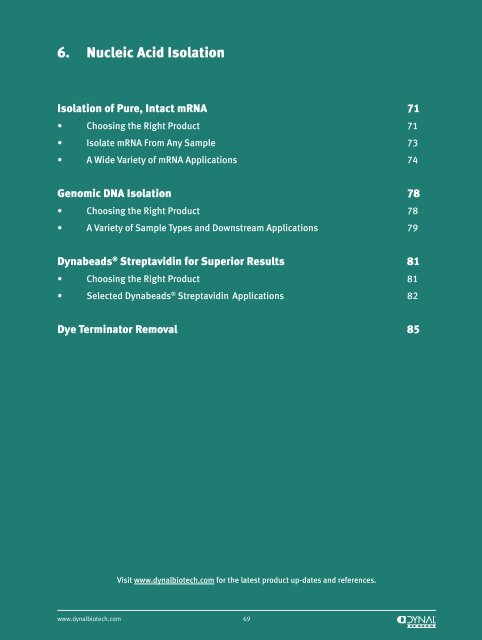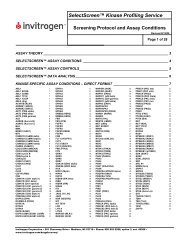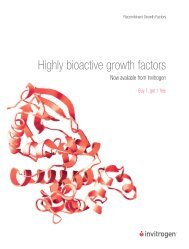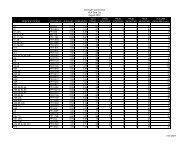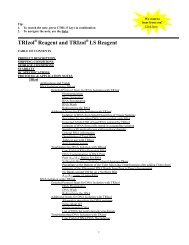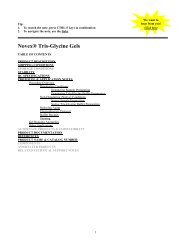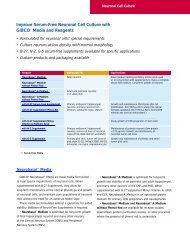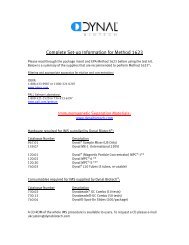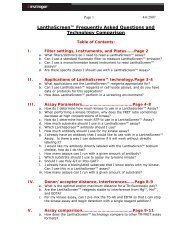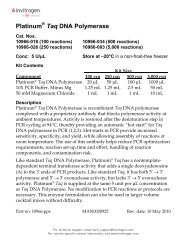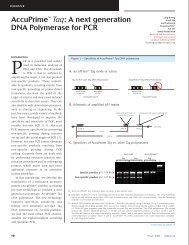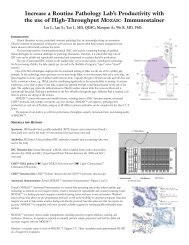Nucleic Acid Isolation.indd - Invitrogen
Nucleic Acid Isolation.indd - Invitrogen
Nucleic Acid Isolation.indd - Invitrogen
You also want an ePaper? Increase the reach of your titles
YUMPU automatically turns print PDFs into web optimized ePapers that Google loves.
6. <strong>Nucleic</strong> <strong>Acid</strong> <strong>Isolation</strong><br />
<strong>Isolation</strong> of Pure, Intact mRNA 71<br />
• Choosing the Right Product 71<br />
• Isolate mRNA From Any Sample 73<br />
• A Wide Variety of mRNA Applications 74<br />
Genomic DNA <strong>Isolation</strong> 78<br />
• Choosing the Right Product 78<br />
• A Variety of Sample Types and Downstream Applications 79<br />
Dynabeads ® Streptavidin for Superior Results 81<br />
• Choosing the Right Product 81<br />
• Selected Dynabeads ® Streptavidin Applications 82<br />
Dye Terminator Removal 85<br />
www.dynalbiotech.com<br />
Visit www.dynalbiotech.com for the latest product up-dates and references.<br />
69
Application Overview<br />
DNA <strong>Isolation</strong><br />
mRNA <strong>Isolation</strong><br />
Depletion<br />
Expansion<br />
Positive <strong>Isolation</strong><br />
Negative <strong>Isolation</strong><br />
Capture of Biotinylated Target<br />
70<br />
Organelle <strong>Isolation</strong><br />
Specific Protein <strong>Isolation</strong><br />
Samples:<br />
Whole Blood<br />
Cord Blood<br />
Mononuclear Cells<br />
Bone Marrow<br />
Buffy Coat<br />
Spleen<br />
Lymph Node<br />
Tissue Digest<br />
www.dynalbiotech.com
<strong>Nucleic</strong> <strong>Acid</strong> <strong>Isolation</strong><br />
<strong>Isolation</strong> of Pure, Intact mRNA<br />
High quality, full length mRNA is necessary for meaningful results in any gene<br />
expression study. Therefore choosing the optimal mRNA sample preparation<br />
method is essential. Magnetic separation with Dynabeads ® Oligo(dT) 25 is a<br />
simple and rapid method to obtain pure, intact mRNA without any DNA or<br />
rRNA contamination (fig. 1).<br />
Main Advantages of Dynabeads ® mRNA <strong>Isolation</strong>:<br />
• Easy-to-use protocol.<br />
• mRNA isolation in only 15 minutes.<br />
• No centrifugation or precipitation.<br />
• Easily adaptable to most robotic systems.<br />
• Isolated mRNA representative and comparable to total RNA.<br />
The scalable protocols consist of only a few steps of pipetting and magnetic<br />
separation, with all operations performed in a single tube. This significantly<br />
reduces the risk of RNase contamination and loss of precious mRNA. The<br />
mRNA isolation protocols are scalable to meet your specific needs. Because<br />
the oligo-dT residues are covalently linked to the surface of the beads, the<br />
Dynabeads ® Oligo(dT) 25 can, if desired, be regenerated and reused at least<br />
four times.<br />
The mRNA isolation protocols do not require any centrifugation or<br />
precipitation steps. The method is therefore perfect for automation, and can<br />
be implemented on most liquid handling robotic platforms (see page 76).<br />
Choosing the Right Product<br />
Dynal Biotech supplies a variety of products and kits for isolation of mRNA, all<br />
with Dynabeads ® Oligo(dT) 25 as the key component (fig. 2). Up to 10 µg mRNA<br />
can be isolated per ml of Dynabeads ® Oligo(dT) 25 , assuming regeneration<br />
of the beads. The final yield will depend on tissue and cell type and the<br />
expression level of the mRNA.<br />
Table 1. Which product to choose for your mRNA isolations.<br />
www.dynalbiotech.com<br />
71<br />
Animal / Plant tissue<br />
mRNA <strong>Isolation</strong><br />
Cultured cells Total RNA<br />
Regenerate<br />
and reuse<br />
·<br />
·<br />
·<br />
·<br />
·<br />
·<br />
· c<br />
Pure cell population<br />
isolated with Dynabeads ®<br />
TTTTTTTTTTTT<br />
+<br />
AAAAAAAAAAAA mRNA<br />
Northern blotting<br />
Dot/blot hybridisation<br />
Primer extension<br />
In vitro translation<br />
S1 nuclease assay<br />
Hybridisation probes<br />
DNA array/chip<br />
TTTTTTTTTTTT<br />
TTTTTTTTTTTT<br />
TTTTTTTTTTTT<br />
Elute<br />
(optional)<br />
Serum / Plasma<br />
Crude lysate<br />
containing<br />
poly A RNA<br />
TTTTTTTTTTTT<br />
AAAAAAAAAAAA mRNA<br />
TTTTTTTTTTTT<br />
AAAAAAAAAAAA mRNA<br />
Reverse<br />
transcription<br />
TTTTTTTTTTTT ................... 1st strand cDNA<br />
AAAAAAAAAAAA mRNA<br />
·<br />
·<br />
·<br />
·<br />
·<br />
·<br />
·<br />
..............<br />
RT-PCR<br />
cDNA synthesis<br />
Solid-phase cDNA library<br />
SAGE-experiments<br />
RACE-experiments<br />
Subtractive hybridisation<br />
Differential display<br />
Fig. 1: <strong>Isolation</strong> of mRNA from different starting<br />
samples and for a wide variety of downstream<br />
applications.<br />
Product Prod. No. Starting sample Sample size<br />
Dynabeads ® Oligo(dT) 25<br />
610.02<br />
610.05<br />
610.50<br />
Any cells, animal- or plant tissue Scalable protocols<br />
Dynabeads ® mRNA Purification Kit 610.06 Total RNA 75 µg total RNA (scalable)<br />
Dynabeads ® mRNA DIRECT Kit<br />
610.11<br />
610.12<br />
Any cells, animal- or plant tissue<br />
Dynabeads ® mRNA DIRECT Micro Kit 610.21 Any cells, animal- or plant tissue<br />
≤ 2 x 10 7 cells<br />
≤ 200 mg animal tissue<br />
≤ 400 mg plant tissue<br />
1-2.5 x 10 4 cells<br />
≤ 5 mg animal tissue<br />
≤ 10 mg plant tissue<br />
+<br />
6<br />
7<br />
<strong>Nucleic</strong> <strong>Acid</strong> <strong>Isolation</strong>
Isolate mRNA from Any Sample<br />
Mammals<br />
Species Starting Sample - Specific Tissue or Cell Type<br />
Bovine Corpus luteum<br />
Dog Leucocytes<br />
Gerbil Cochlear cells<br />
Guinea pig Organ of corti (inner ear), Spiral ganglion (inner ear)<br />
Human<br />
Mouse<br />
Pig Adipose tissue, Heart<br />
Rat<br />
Birds Pigeon Breast muscle, Frozen tissues, Liver<br />
Fish<br />
Amniocytes, B cells, Blastocysts, Blood, Bone marrow, Brain, Breast, Bronchoalveolar<br />
cells, Cartilage, CD34 + cells, Cervical cancer cells, Chondrocytes, Colon carcinoma<br />
cells, Cultured cells, Embryo, Fibroblasts, Glomeruli (kidney), Gut, Hair roots, Heart,<br />
Hepatocytes, Keratinocytes, Kidney, Langerhans cells, Leucocytes, Leukemia cells,<br />
Liver, Lung, Lymphoblasts, Lymphocytes, Lymphoid cells, Monocytes, Muscles,<br />
Neutrophils, Oocytes, Pancreas, Peripheral blood mononuclear cells (PBMC), Peritoneal<br />
exudate cells, Placenta, Platelets, Retina, Skin, Stem cells, T cells, Testicles, Tumours,<br />
Umbilical vein endothelial cells<br />
Brain, Cortex, Embryonic tissue, Epidermis, Eye, Fibroblasts, Germ cells, Glomeruli<br />
(kidney), Heart, Interscapular brown adipose tissue pad, Kidney, Kidney tubules, Liver,<br />
Lung, Retina, Skeletal muscle, Testicles<br />
Adrenals, Brain, Cerebral cortex (pre-optic area), Heart, Hypothalamus (brain), Kidney,<br />
Liver, Lung, Muscle, Neuronal cells (brain), Organ of corti (inner ear), Pancreas,<br />
Pituitary, Renal cortex (kidney), Spiral ganglion (inner ear), Spleen<br />
Trout Brain, Eggs, Fibroblasts, Liver, Muscle, Ovaries, Pronephros<br />
Zebrafish Embryo<br />
Amphibians Xenopus laevis Liver, Ovaries<br />
Molluscs Sea Urchin Blastocysts, Coelomocytes, Eggs<br />
Insects Drosophila melanogaster Ovary, Whole insects<br />
Plants<br />
Yeasts<br />
Parasites<br />
Viruses<br />
Arabidopsis thaliana<br />
Hordeum vulgare<br />
Brassica oleracea Leaves, Root, Stigma<br />
Lupinus angustifolius Cotyledon<br />
Flowers, Leaves, Roots, Rosette leaves, Seed, Silique, Stem, Stem leaves,<br />
Whole plants<br />
Embryo, Endosperm , Leaves, Root, Seed aleurone, Seed embryos, Seed endosperm,<br />
Seed<br />
Zea mays Embryos, Endosperm, Flowers, Leaves, Ovules, Root, Seed<br />
Nicotiana tabacum Bud, Leaf (nuclei), Leaves, Root (nuclei), Seed, Stem<br />
Pisum sativum Root apical meristems (nuclei)<br />
Solanum tuberosum Leaves, Stolon tips<br />
Picea ssp. Root<br />
Lycopersicon ssp.<br />
Candida tropicalis Cell culture<br />
Hansenula polymorpha Soil samples<br />
Saccharomyces cerevisiae Cell culture, Soil samples<br />
Cryptosporidium parvum Oocyst<br />
Schistosoma mansoni Whole worm<br />
HCMV Infected cells<br />
HIV-1<br />
HIV-2 Plasma<br />
HTLV-I/II Infected cells<br />
Human coronavirus Infected cells<br />
Poliovirus Infected cells<br />
Epidermal leaf cell (single cells), Flower bud, Flowers, Guard cell in leaf (single cells),<br />
Leaves<br />
Cells in broncho-alveolar washes, Cerebrospinal fluid, PBMC, Plasma, Serum,<br />
T lymphocytes cell line, CD4+ cells<br />
Table 2. An overview of some of the many sample types from which mRNA has been isolated using Dynabeads ® Oligo (dT) 25 . All information from published<br />
literature. For a full reference-list, please contact Dynal Biotech Technical Support.<br />
72<br />
www.dynalbiotech.com
Direct mRNA isolation with the Dynabeads ® mRNA DIRECT Kit* (Product<br />
no. 610.11/12) takes only 15 minutes from start to finish. The starting<br />
sample can be crude extracts of animal tissues, plants and cells. This new<br />
and improved kit contains 5 times more Dynabeads ® Oligo(dT) 25 .<br />
The protocol and kit format of the Dynabeads ® mRNA DIRECT Micro Kit<br />
(Product no. 610.21) is adjusted to small sample requirements, providing<br />
a fast and reliable way to combine direct mRNA isolation followed by direct<br />
RT-PCR amplification.<br />
The mRNA can alternatively be purified from total RNA with the Dynabeads ®<br />
mRNA Purification Kit (Product no. 610.06). A typical mammalian cell<br />
contains about 10 pg of total RNA, of which 1-5 % is mRNA.<br />
Dynabeads ® Oligo(dT) 25 (Product No. 610.02/05/50) is the main component<br />
in all of the above mentioned kits and is also available as a stand-alone<br />
product. The ease and speed of magnetic isolation and handling of mRNA<br />
provide a superior alternative to traditional methods.<br />
Isolate mRNA from Any Sample!<br />
As documented in a large number of scientific publications, Dynabeads ®<br />
Oligo(dT) 25 have been used to isolate mRNA from virtually any cell or tissue<br />
sample. Effective cell lysis and rapid handling make it possible to isolate<br />
mRNA from tough samples such as yeast cells, plant material with high<br />
starch and/or RNase content, paraffin-embedded tissues and even directly<br />
from human whole blood.<br />
The table on the facing page (table 2), lists some of the many different sample<br />
types where Dynabeads ® Oligo(dT) 25 have been used to isolate mRNA directly<br />
from a crude starting sample (all information from published literature).<br />
www.dynalbiotech.com<br />
73<br />
Choose the Right Product<br />
New &<br />
improved<br />
Fig. 2: The true uniform size and shape of<br />
Dynabeads ® Oligo (dT) 25 provide rapid and<br />
efficient binding kinetics and highly reproducible<br />
results.<br />
6<br />
7<br />
<strong>Nucleic</strong> <strong>Acid</strong> <strong>Isolation</strong>
A Wide Variety of mRNA Applications<br />
Fig. 3: Positive isolation of a specific cell type<br />
using antibody-coated Dynabeads ® , followed by<br />
mRNA isolation using Dynabeads ® Oligo(dT) 25 .<br />
MW<br />
MW<br />
.<br />
.<br />
+<br />
+<br />
Patient 1 Patient 2 Patient 3 Patient 4<br />
Fig. 4: <strong>Isolation</strong> of DNA and mRNA from the same<br />
blood samples using Dynabeads ® on the TECAN<br />
Genesis ® platform. A: CD19 PCR on genomic DNA.<br />
B: CD19 RT-PCR on mRNA. Both the DNA and<br />
mRNA isolations were performed on 3 parallels<br />
of 4 patient samples.<br />
CK19<br />
EPCAM<br />
Pure cells isolated with cell-specific Dynabeads Ò<br />
TTTTTTTT<br />
AAAAAAAAA<br />
Ò<br />
<strong>Isolation</strong> of mRNA with Dynabeads Oligo(dT) 25<br />
for use in further downstream manipulations<br />
Patient 1 Patient 2 Patient 3 Patient 4<br />
Number of cells: 1 1 5 5 10 10<br />
Fig. 5: Single cell RT-PCR sensitivity of mRNA<br />
isolated from 1, 5 and 10 SW480 carcinoma cells.<br />
Single cells were picked with a micromanipulator<br />
and mRNA isolated with Dynabeads ® Oligo(dT) 25 .<br />
The mRNA was then reverse transcribed while still<br />
attached to the beads and the resulting solidphase<br />
cDNA library included directly in a full PCR.<br />
The solid-phase cDNA library used for detection of<br />
the carcinoma cell specific CK19 transcript (upper<br />
panel) was reused as template also in a second<br />
round of PCR, this time detecting the carcinoma<br />
specific transcript EPCAM (lower panel).<br />
A<br />
B<br />
A Wide Variety of mRNA Applications<br />
mRNA from Pure Cell Populations<br />
Molecular analyses are increasingly employed at the resolution of pure cell<br />
populations. Data from such homogeneous cell samples are much more<br />
informative than that from larger samples of mixed cells.<br />
As shown in the diagram on page 70, Dynabeads ® -based technology allows<br />
the combined isolation of pure cells, nucleic acids and proteins from the<br />
same sample.<br />
Dynal Biotech offers a wide range of Dynabeads ® pre-coated with specific<br />
antibodies against the major types of blood cells (chapter 3). In addition to the<br />
pre-coated Dynabeads ® , secondary-coated or surface activated Dynabeads ®<br />
can easily be coupled with your choice of antibody to isolate any specific cell<br />
type. This offers the unique possibility of combining separation of specific<br />
cell populations with mRNA isolation for downstream analysis (fig. 3).<br />
The scalable magnetic mRNA isolation technology simplifies automation of<br />
sample preparation protocols (fig. 4).<br />
mRNA from Single Cells<br />
It is often necessary or desirable to analyse gene expression with sensitivity at<br />
the single cell level, particularly if the amount of available material is sparse.<br />
Specific examples include embryology, neurology, stem cell studies, studies<br />
of small solid tumours or circulating micrometastatic cells, or cells obtained<br />
from fine needle aspirates or laser capture microdissection.<br />
Dynabeads ® -based technology enables molecular characterisation even down<br />
to single-cell profiling (fig. 5). Further examples of single cell profiling include<br />
the work by Karrer et al. Starting from single tomato epidermal cells, they<br />
isolated mRNA for construction of cDNA libraries (1). Klein et al. combined<br />
transcriptome and genome analysis of single micrometastatic cells using<br />
Dynabeads ® Oligo(dT) 25 (2).<br />
As described in chapter 3, pure cells for gene expression analysis can be<br />
obtained using cell-specific Dynabeads ® . Dynabeads ® Epithelial Enrich have<br />
been used to capture a single epithelial cancer cell spiked into 1 ml of blood.<br />
The mRNA was isolated from the positively isolated cell using Dynabeads ®<br />
Oligo(dT) 25 , reverse transcribed into a solid-phase cDNA library and the<br />
carcinoma cell specific transcripts CK19 and EPCAM detected by solid-phase<br />
RT-PCR. Konishi et al. have used Dynabeads ® to isolate single live human<br />
neurons (3).<br />
74<br />
www.dynalbiotech.com
mRNA for cDNA Libraries<br />
Dynabeads ® Oligo(dT) 25 are particularly useful for the construction of cDNA<br />
libraries (fig. 6), which can be used for cDNA amplification, cDNA cloning,<br />
RACE experiments and subtractive hybridisation.<br />
When preparing a solid-phase cDNA library, the mRNA is first captured<br />
onto the Dynabeads ® Oligo(dT) 25 . The beads are then added directly to the<br />
RT-reaction, where the bead-bound oligo-dT residues act as primers for<br />
first strand cDNA synthesis. As the operations take place on a solid-phase,<br />
changing of buffers is fast, simple and effective.<br />
The patented Dynabeads ® solid-phase cDNA synthesis technology is<br />
compatible with various commercially available cDNA synthesis kits. The<br />
beads do not inhibit enzymatic reactions, and bead-bound mRNA can be<br />
added directly to the RT-reaction without any diluting elution steps. Without<br />
eluting the mRNA from the beads prior to RT-PCR amplification, large numbers<br />
of cell clones can be rapidly screened for their expression of any gene. This<br />
makes it possible to generate solid-phase cDNA libraries even from a single<br />
cell (1). In addition, because the first strand cDNA is covalently linked to<br />
the beads, the cDNA library can be regenerated and reused for an almost<br />
unlimited number of times.<br />
mRNA for RT-PCR and Real-Time PCR<br />
Dynabeads ® Oligo(dT) 25 and the Dynabeads ® mRNA DIRECT Micro Kit<br />
offer a fast, simple and reliable way to combine mRNA isolation and RT-PCR<br />
or real-time PCR. The isolated mRNA is DNA-free as working with very small<br />
numbers of cells limits DNA contamination.<br />
Dynabeads ® Oligo(dT) 25 can be applied directly to PCR (or any other enzymatic<br />
reactions) as the presence of the beads does not inhibit or reduce the<br />
enzymatic activity. This is because the iron is sealed inside the Dynabeads ®<br />
by an inert polymer shell that prevents leakage and inhibition of enzymes.<br />
The benefit of adding the beads to the RT-PCR is that elution, and thereby<br />
dilution, of the mRNA is avoided. Dynabeads ® Oligo(dT) 25 also have negligible<br />
autofluorescence, and can therefore be applied directly in real-time PCR<br />
instruments such as the ABI Prism ® 7000 without interfering with the results<br />
of the analysis.<br />
mRNA for Northern Blotting<br />
Only 1-5% of the total cytoplasmic RNA in a typical eukaryotic cell is mature<br />
mRNA, and many transcripts occur in medium to low abundance. Using<br />
mRNA rather than total RNA for your Northern analysis will result in cleaner<br />
and more sensitive results. The highly purified and intact mRNA isolated<br />
with Dynabeads ® Oligo(dT) 25 is ideal for Northern blotting, and gives reduced<br />
background and increased intensity of signals (fig. 7).<br />
The mRNA can either be isolated directly from the cells or tissue with<br />
Dynabeads ® Oligo(dT) 25 or one of the Dynabeads ® mRNA DIRECT kits,<br />
or from total RNA with the Dynbeads ® mRNA Purification Kit. The kits are<br />
flexible and scalable to fit any sample size, and are therefore particularly<br />
useful for preparation of mRNA for Northern blotting from small amounts of<br />
sample material.<br />
www.dynalbiotech.com<br />
75<br />
A Wide Variety of mRNA Applications<br />
TTTTTTTTTTTT<br />
TTTTTTTTTTTT<br />
TTTTTTTTTTTT<br />
Isolate mRNA by<br />
magnetic separation<br />
TTTTTTTTTTTT<br />
AAAAAAAAAAAA mRNA<br />
Synthesize first-strand<br />
cDNA without eluting the<br />
mRNA off the Dynabeads ®<br />
TTTTTTTTTTTT ................. 1st strand cDNA<br />
AAAAAAAAAAAA mRNA<br />
Fig. 6: mRNA isolated from a starting sample is<br />
easily converted to cDNA, even without elution<br />
from the Dynabeads ® Oligo(dT) 25 . This enables<br />
further downstream manipulations of the resulting<br />
solid-phase cDNA library.<br />
Fig. 7: Unambiguous Northern analysis of timecourse<br />
expression of Cyclin D 1 mRNA in human<br />
airway smooth muscle with (T) and without (C)<br />
stimulation with thrombin for 2,4,8, or 16 hours.<br />
In the left panel, 5 mg total RNA was loaded per<br />
lane. In the right panel, mRNA (extracted from<br />
75 µg total RNA using the Dynabeads ® mRNA<br />
Purification Kit) was loaded per lane. Courtesy of<br />
E. Guida and A. Stewart, St. Vincents Hospital,<br />
VIC, Australia.<br />
6<br />
7<br />
<strong>Nucleic</strong> <strong>Acid</strong> <strong>Isolation</strong>
A Wide Variety of mRNA Applications<br />
A B<br />
Fig. 8: Functional genomics approach using<br />
Dynabeads ® to find target genes in testicular<br />
cancer. A: Microarray using input mRNA, shows<br />
either up- (red) or down- (green) regulated genes<br />
in tumour relative to normal testis. B: Two of the<br />
genes were also validated as up-regulated at<br />
their protein level. Courtesy of R. Skotheim and<br />
R. A. Lothe, the Norwegian Radium Hospital,<br />
Oslo, Norway.<br />
Fig. 9: The Dynabeads ® mRNA isolation method<br />
is easily adapted to commercially available<br />
liquid handling platforms. Protocols have been<br />
developed for the Biomek ® 2000 from Beckman<br />
Coulter and the Tecan Genesis ® from Tecan AG.<br />
mRNA for Microarrays<br />
Dynabeads ® Oligo(dT) 25 are perfect for purifying mRNA for expression profiling<br />
applications. Direct mRNA isolation eliminates the background noise often<br />
observed when preparing cDNA probes from purified total RNA.<br />
The hybridisation kinetics between mRNA and the Dynabeads ® are extremely<br />
fast and efficient, and comparable to that of free solution hybridisation. This<br />
ensures negligible loss of the precious mRNA.<br />
The many types of arrays/chips commercially available require different<br />
quantities of mRNA. The possibility of scaling the isolation protocols allows<br />
you to isolate mRNA from any quantity of cells. Dynabeads ® Oligo(dT) 25 can<br />
therefore be used to prepare the amount of mRNA required for any type of<br />
micro- and macroarrays or chips (one example is shown in fig. 8). Please<br />
contact Technical Support or go to www.dynalbiotech.com for a list of<br />
references where Dynabeads ® have been used to prepare mRNA for various<br />
types of analysis.<br />
mRNA in Automated Protocols and IVD Assays<br />
Sample preparation with Dynabeads ® Oligo(dT) 25 facilitates efficient mRNA<br />
concentration. No centrifugation or precipitation steps are required, as<br />
washing and buffer-changes are easily accomplished by the use of a magnet.<br />
The scalable magnetic mRNA isolation protocols are perfect for automation<br />
and can be implemented on most liquid handling robotic platforms (fig. 9).<br />
For further information on the available protocols, please contact Technical<br />
Support or visit our web-site at www.dynalbiotech.com.<br />
The unique uniformity of size, surface area and superparamagnetic properties<br />
of the Dynabeads ® are not merely for cosmetic benefit. These properties are<br />
also the basis for optimal accessibility and reaction kinetics, in turn enabling<br />
rapid, yet sensitive, and reliable capture of mRNA. The beads do not inhibit<br />
enzymatic activity, and bead-bound mRNA can be included in downstream<br />
magnetic handling as well as detection assays.<br />
The uniform characteristics and low batch-to-batch variation of the<br />
Dynabeads ® allow our customers to cut costs in their internal QC-testing,<br />
without compromising the reproducibility or quality of the results.<br />
ViroLogic, Inc. (San Francisco, CA, USA) uses Dynabeads ® Oligo(dT) 25 in<br />
their advancement in the fields of individualised medicine and pharmacogenomics.<br />
In addition to being a service company, ViroLogic, Inc. discovers<br />
and develops innovative products used by pharmaceutical companies to<br />
guide and improve treatment of serious viral diseases such as AIDS and<br />
hepatitis. Their fast and sensitive PhenoSense technology is used for<br />
assessing phenotypic drug resistance and susceptibility in viruses that cause<br />
these diseases. For general information on the availability of Dynabeads ®<br />
supplied on an OEM basis, please refer to chapter 7. See also chapter 11 for<br />
further information on Dynal Biotech’s Quality Systems.<br />
76<br />
www.dynalbiotech.com
Ordering Information<br />
www.dynalbiotech.com<br />
References for mRNA <strong>Isolation</strong> and Applications<br />
77<br />
Relevant Dynabeads ® References<br />
1. Karrer EE. et al. (1995) In situ isolation of<br />
mRNA from individual plant cells: creation of<br />
cell-specific cDNA libraries. PNAS 92:3814-<br />
3818.<br />
2. Klein CA. et al. (2002) Combined transcriptome<br />
and genome analysis of single<br />
micrometastatic cells. Nature Biotech<br />
20:387-392.<br />
3. Konishi Y. et al. (2002) <strong>Isolation</strong> of living<br />
neurons from human elderly brains using<br />
the immunomagnetic sorting DNA-linker<br />
system. Am J Pathol 161:1567-1576.<br />
Product Volume Product No.<br />
Dynabeads ® Oligo(dT) 25<br />
Dynabeads ® mRNA DIRECT Kit*<br />
Dynabeads ® Oligo(dT) 25 , Lysis/Binding Buffer, Washing Buffers,<br />
10 mM Tris-HCl, Reconditioning Solution and Storage Buffer.<br />
Dynabeads ® mRNA DIRECT Micro Kit<br />
Dynabeads ® Oligo(dT) 25 , Lysis/Binding Buffer, Washing Buffers and 10 mM Tris-HCl.<br />
Dynabeads ® mRNA Purification Kit<br />
Dynabeads ® Oligo(dT) 25 , Binding Buffer, Washing Buffer and 10 mM Tris-HCl.<br />
* 5 times more Dynabeads ® Oligo(dT) 25 added.<br />
NEW<br />
2 ml<br />
5 ml<br />
50 ml<br />
20 isolations<br />
40 isolations<br />
610.02<br />
610.05<br />
610.50<br />
610.11<br />
610.12<br />
100 isolations 610.21<br />
10 isolations 610.06<br />
6<br />
7<br />
<strong>Nucleic</strong> <strong>Acid</strong> <strong>Isolation</strong>
Choose the Right Product<br />
Fig. 10. Principle for isolation of DNA using<br />
Dynabeads ® DNA DIRECT TM Universal.<br />
Fig. 11. Dynabeads ® DNA DIRECT TM are suitable<br />
for isolating pure, high quality DNA down to 10<br />
cells. DNA was isolated from different numbers<br />
of leucocytes, and used for PCR amplification of<br />
the GAPDH gene.<br />
Product Sample Volume<br />
Dynabeads ® DNA DIRECT Universal<br />
Dynabeads ® DNA DIRECT Blood<br />
Dynabeads ® Genomic DNA Blood<br />
Table 3: Which product to choose for your DNA isolation.<br />
Genomic DNA <strong>Isolation</strong><br />
High quality DNA is crucial in DNA diagnostics, mutation detection and SNP<br />
analysis, pharmacogenomics, tissue typing and many other applications.<br />
Biomagnetic separation with Dynabeads ® offers a simple, rapid and easily<br />
automated method for isolating high purity DNA from a variety of different<br />
starting samples.<br />
Main Advantages of Dynabeads ® DNA <strong>Isolation</strong>:<br />
• PCR-ready DNA isolated in down to 10 minutes.<br />
• Eliminate contaminating inhibitors.<br />
• Highly reproducible results.<br />
• Perfect for automation.<br />
PCR-ready genomic DNA of high molecular weight can be isolated using<br />
Dynabeads ® . The protocols consist of only a few steps of pipetting and<br />
magnetic separation, with all operations performed in a single tube.<br />
Contaminating PCR inhibitors are eliminated without any centrifugation steps<br />
or use of phenol/chloroform.<br />
Choosing the Right Product<br />
The Dynabeads ® DNA DIRECT Universal kit (Product no. 630.06) is<br />
designed for user-friendly isolation of genomic DNA directly from crude<br />
material in only 10 minutes. The kit is particularly useful for isolation of<br />
DNA from bacteria and cultured cells, and also from clinical specimens and<br />
tissues from various species. Only a minute amount of starting material is<br />
required. At least 200 ng of PCR-ready DNA is isolated per sample, sufficient<br />
for at least 10 PCR reactions.<br />
The Dynabeads ® DNA DIRECT Blood kit (Product no. 631.02) supports<br />
100 isolations from 100 µl of blood per sample, sufficient for at least 100<br />
PCR amplifications. The protocol can be modified to allow isolation from<br />
500 µl blood samples, providing enough template DNA for 1,000 PCR<br />
amplifications.<br />
The Dynabeads ® Genomic DNA Blood kit (Product no. 634.01/02) is designed<br />
for isolation of ultra-pure DNA from 200 µl fresh human blood. In the two-step<br />
procedure, leucocytes are first isolated from the erythrocytes and serum by<br />
both Dynabeads ® CD15 and CD45. DNA from lysed pure leucocytes is then<br />
captured onto DNA binding Dynabeads ® .<br />
Fresh/frozen blood ≤ 30 µl<br />
Cultured cells ≤ 10 4 cells<br />
Animal/plant tissue ≤ 100 mg<br />
Bacteria ≤ 10 7 -10 8 cells<br />
Fresh or frozen blood,<br />
bone marrow<br />
Fresh blood (stored up to<br />
4 days at 4-25 0 C)<br />
100-500 µl<br />
200 µl<br />
78<br />
Typical<br />
Applications<br />
PCR<br />
PCR, RFLP, SSCP,<br />
Southern Blotting<br />
Any downstream<br />
application<br />
Automated<br />
protocols<br />
TECAN Genesis ®<br />
Kingfisher ®<br />
Biomek ® 2000<br />
TECAN Genesis ®<br />
Kingfisher ® mL, Biomek ® FX<br />
www.dynalbiotech.com
A Variety of Sample Types and Downstream<br />
Applications<br />
DNA from Bacteria<br />
Dynabeads ® DNA DIRECT Universal are particularly useful for rapid isolation<br />
of bacterial genomic DNA from bacterial cultures, and also for isolating DNA<br />
from bacteria in food, clinical or environmental samples.<br />
Specific examples include: Listeria monocytogenes in milk, Leptospira<br />
interrogans in blood, cyanobacteria in water samples, Neisseria meningitidis,<br />
Haemophilus influenza, Streptococcus pneumoniae, Streptococcus agalactiae,<br />
Listeria monocytogenes and E. coli in cerebrospinal fluid and blood, (fig. 12)<br />
and Mycobacterium tuberculosis in lung and lymph node tissue. For a<br />
complete reference list, please visit www.dynalbiotech.com.<br />
DNA from Blood<br />
DNA isolation kits from Dynal Biotech are suitable for isolation of DNA from<br />
blood.<br />
Dynabeads ® DNA DIRECT Universal are recommended for the rapid isolation<br />
of DNA from small volumes, or even finger-prick samples, of blood. One test<br />
will isolate 600 ng - 1 µg DNA from a 30 µl blood sample, sufficient for 30-50<br />
PCR amplifications. The protocol can be fully automated on most liquid<br />
handling robots.<br />
The Dynabeads ® DNA DIRECT Blood kit isolates DNA from up to 0.5 ml<br />
blood samples in less than 15 minutes. One test provides enough template<br />
DNA for up to 1,000 PCR amplifications. The protocol is amenable to semiautomation<br />
as it includes only one centrifugation step.<br />
Dynabeads ® Genomic DNA Blood kit isolates DNA from 200 µl fresh blood<br />
and typically yields between 6-9 µg DNA per sample depending on the<br />
number of white blood cells in the blood sample. The protocol is ideal for<br />
walk-away automation.<br />
DNA from Other Clinical Samples<br />
Dynabeads ® DNA DIRECT Universal is excellent for the rapid isolation of DNA<br />
from small amounts of solid tumours, mouth wash (fig. 13), buccal scrapes,<br />
urine, bile and faeces. After DNA isolation, the beads can be added directly<br />
to the PCR without prior elution. The excellent sensitivity allows isolation of<br />
DNA even from single cells.<br />
DNA for Tissue Typing<br />
Dynal Biotech HLA Diagnostics offers a complete range of products for tissue<br />
typing. For more information see chapter 9 or go to www.dynalbiotech.com.<br />
The Dynabeads ® DNA DIRECT Blood kit is ideal for rapid and simple DNA<br />
extraction for low-resolution tissue typing with the Dynal Biotech Reli SSO<br />
products. The product isolates DNA from up to 0.5 ml blood, and the DNA is<br />
sufficient for at least 13 SSO PCR amplifications.<br />
www.dynalbiotech.com<br />
79<br />
A Variety of Sample Types<br />
Fig. 12: PCR-products from DNA preparations using<br />
the Dynabeads ® DNA DIRECT Universal kit, from<br />
the following strains: N. meningitidis (lanes 2-3),<br />
H. influenzae (lanes 4-5), S. pneumoniae (lanes<br />
6-7), S. agalactiae (lanes 8-9), L. monocytogenes<br />
(lanes 10-11) and E. coli (lanes 12-13). Lanes 1<br />
and 16: MW markers; lane 14: negative control;<br />
lane 15: positive PCR-control. MW-sizes of all<br />
PCR-products were as expected. Courtesy of<br />
A. Bäckman, Örebro Medical Center Hospital,<br />
Örebro, Sweden.<br />
Fig. 13: PCR on DNA isolated from mouth wash<br />
specimen with Dynabeads ® DNA DIRECT TM .<br />
Lane 1: 100 bp ladder. Lane 3: extraction control<br />
(isolation from water). Lane 4: negative PCR<br />
control. Lanes 5-12: 157 bp K-ras PCR product<br />
from patient samples. Courtesy of M. Longfellow,<br />
Molecular Pathology Laboratory, The General<br />
Infirmary, Leeds, UK.<br />
6<br />
7<br />
<strong>Nucleic</strong> <strong>Acid</strong> <strong>Isolation</strong>
A Variety of Downstream Applications<br />
Fig. 14: Identification of 3 mice transgenic<br />
for human Retinoic <strong>Acid</strong> Receptor (RAR) cDNA<br />
sequences. DNA isolated from 3-5 mg tail-tissue<br />
from each of 6 mice using the Dynabeads ® DNA<br />
DIRECT Universal kit. GAPDH amplification was<br />
used as a positive PCR control. Only 10% of the<br />
isolated DNA was used as template.<br />
Ordering Information<br />
DNA for the Identification of Transgenic Animals<br />
Dynabeads ® DNA DIRECT Universal kit is ideal for isolating DNA directly<br />
from small tissue samples. Mouse tail snips are often a preferred source of<br />
DNA for PCR-based identifications of transgenic animals in a litter (fig. 14).<br />
With Dynabeads ® DNA DIRECT Universal, PCR-ready DNA is isolated in<br />
less than 10 minutes. If desired, Dynabeads ® DNA DIRECT Universal can<br />
also be used to isolate DNA from mouse ear punch tissue, whole blood and<br />
other starting samples.<br />
Automated DNA <strong>Isolation</strong> Protocols<br />
The medium to high throughput Dynabeads ® DNA isolation protocols are<br />
implemented on a variety of liquid handling robotic platforms, thereby<br />
reducing the risk of human error while improving quality and reproducibility.<br />
Biomagnetic sample preparation allows for efficient target concentration<br />
without any centrifugation or precipitation steps. Washing and buffer changes<br />
are easily accomplished by the use of a magnet.<br />
For further information and to receive the scripts for the available automated<br />
DNA isolation protocols on any particular platform, please contact Dynal<br />
Biotech Technical Support. You can also download the scripts from our website<br />
at www.dynalbiotech.com.<br />
The low batch-to-batch variation of Dynabeads ® guarantees the quality and<br />
reproducibility of your results. For general information on the availability of<br />
Dynabeads ® supplied on an OEM basis, please refer to chapter 7. See also<br />
chapter 11 for further information on Dynal Biotech’s Quality Systems.<br />
Product Volume Product No.<br />
Dynabeads ® DNA DIRECT Universal<br />
Dynabeads ® supplied in a Lysis Buffer, 10 M NaOH,<br />
Washing Buffer and Resuspension Buffer.<br />
Dynabeads ® DNA DIRECT Blood<br />
Red Cell Lysis Buffer, Dynabeads ® supplied in a Lysis Buffer,<br />
Washing Buffer and Resuspension Buffer.<br />
Dynabeads ® Genomic DNA Blood<br />
Dynabeads ® Pan Leucocytes, Cell Washing Buffer, BSA,<br />
Dynabeads ® supplied in a Lysis Buffer, Washing Buffer and Resuspension Buffer.<br />
80<br />
300 isolations 630.06<br />
100 isolations 631.02<br />
60 isolations<br />
384 isolations<br />
634.01<br />
634.02<br />
www.dynalbiotech.com
Dynabeads ® Streptavidin for Superior<br />
Results<br />
Dynabeads ® with recombinant streptavidin covalently attached to the bead-<br />
surface enable efficient isolation and handling of any biotinylated target<br />
molecule (fig. 15). The very high binding affinity of the streptavidin-biotin<br />
interaction (K D = 10 -15 ) is utilised in a vast number of molecular applications.<br />
Some of these applications are described on the following pages.<br />
Main Advantages of Dynabeads ® Streptavidin:<br />
• Flexible solid-phase protocols with liquid-phase reaction kinetics.<br />
• Direct and fast capture of any biotinylated target.<br />
• High batch-to-batch reproducibility gives consistent results in your<br />
application.<br />
• Biomagnetic protocols are easily adapted to automated platforms.<br />
The streptavidin-coupled Dynabeads ® are coated with a monolayer - not a<br />
multilayer - of recombinant streptavidin. This leaves the vast majority of the<br />
biotin binding sites sterically available for binding, not only of free biotin,<br />
but also for binding of biotinylated ligands/targets.<br />
The absence of excess physically adsorbed streptavidin ensures that only a<br />
negligible amount of streptavidin will be able to leak. Batch-to-batch variability<br />
is minimised, and the reproducibility of your results is optimised.<br />
Choosing the Right Product<br />
Three different streptavidin-coupled Dynabeads ® are available to meet the<br />
requirements of different applications. Dynabeads ® M-270 Streptavidin and<br />
Dynabeads ® MyOne Streptavidin C1 are particularly suitable for nucleic acid<br />
applications (table 4). Their negatively charged hydrophilic surface (at pH 7)<br />
ensures negligible non-specific binding of irrelevant nucleic acids. Lysis in GTC<br />
buffers with the beads present is possible, and the beads also show minimal<br />
aggregation in high salt buffers used, for example, for hybridisation.<br />
Dynabeads ® M-270 Streptavidin (Product no. 653.05/06/07)<br />
2.8 µm medium to high capacity beads ideal for applications such as<br />
preparation of single-stranded DNA, SAGE, and solid-phase hybridisation<br />
(fig. 16). The production of Dynabeads ® M-270 Streptavidin follows a<br />
validated process in compliance with the cGMP for medical devices.<br />
Dynabeads ® MyOne Streptavidin C1 (Product no. 650.01/02/03)<br />
1.0 µm ultra-high capacity beads ideal for molecular displays and nucleic<br />
acid assays. The small size, combined with the characteristic shape,<br />
(fig. 17), gives a very high surface area. This means high capacity for the<br />
corresponding target molecule and maximum signal generation. The beads<br />
have a high iron content that ensures rapid magnetic separation. The<br />
uniform size, low sedimentation rate and high magnetic mobility together<br />
make these beads the optimal choice for any automated application.<br />
Dynabeads ® M-280 Streptavidin (Product no. 112.05/06, 602.10)<br />
2.8 µm beads suitable for a wide range of applications. Please see chapter<br />
7 for further information on this product.<br />
www.dynalbiotech.com<br />
81<br />
Streptavidin-Coupled Dynabeads ®<br />
Mixed starting sample<br />
®<br />
Dynabeads Streptavidin<br />
Any biotinylated ligand<br />
Target binding<br />
Magnetic separation<br />
Fig. 15: Direct/indirect magnetic separation via<br />
the biotin–streptavidin interaction. A wide variety<br />
of ligands/probes can be used to isolate target<br />
molecules, relevant to your specific application<br />
or assay.<br />
Fig. 16: 2.8 µm Dynabeads ®<br />
Fig. 17: 1.0 µm Dynabeads ®<br />
6<br />
7<br />
<strong>Nucleic</strong> <strong>Acid</strong> <strong>Isolation</strong>
Amount immobilised (pmol/mg beads)<br />
Choose the Right Product<br />
90<br />
80<br />
70<br />
60<br />
50<br />
40<br />
30<br />
20<br />
10<br />
0<br />
55<br />
22<br />
35<br />
11<br />
67,5<br />
24,5<br />
100 1000 10000<br />
Fragment length (bp)<br />
83,4<br />
Fig. 18: B&W Buffer (red) is the standard buffer<br />
recommended for use with Dynabeads ® M-280<br />
Streptavidin. The specially designed Binding<br />
Solution (green) supplied in the Dynabeads ®<br />
kilobase-BINDER Kit significantly increases the<br />
binding capacity for large (>2kb) double stranded<br />
DNA fragments.<br />
®<br />
Dynabeads Streptavidin<br />
+<br />
Immobilised DNA fragment<br />
Biotinylated DNA fragment<br />
Denature and remove non-biotinylated strand<br />
Fig. 19: Double-stranded PCR products immobilised<br />
onto Dynabeads ® Streptavidin are easily<br />
converted to single-stranded templates for use<br />
in downstream applications. Elution conditions<br />
can be heating, alkali denaturation or change in<br />
ionic strength.<br />
Dynabeads ® M-270 Streptavidin Dynabeads ® MyOne TM Streptavidin C1<br />
Basic bead Hydrophilic carboxylic acid Hydrophilic carboxylic acid<br />
Diameter 2.8 ± 0.2 µm 1.05 ± 0.1 µm<br />
Size distribution cv < 3% cv < 3%<br />
Blocking protein None None<br />
Isoelectric point pH 4.5 pH 5.2<br />
Charge at pH 7 - 50 mV - 35 mV<br />
Iron content (Ferrites) 14% (20%) 26% (37%)<br />
Free biotin binding > 650 - 1350 pmol/mg > 2500 pmol/mg<br />
Binding of biotinylated Ig 5 - 10 µg/mg 15 - 20 µg/mg<br />
Table 4: Overview of the characteristics for the two types of streptavidin-coupled Dynabeads ® recommended for nucleic acid applications.<br />
Selected Dynabeads ® Streptavidin<br />
Applications<br />
Over the last 15 years, streptavidin-coupled Dynabeads ® have been used in<br />
a large number of labs for a wide range of applications, several of which are<br />
covered by patents or patent-applications.<br />
The biotin-streptavidin linkage system is extremely flexible and can be used<br />
to capture almost any biotinylated target for a wide variety of downstream<br />
applications. On the following pages we present some of the key applications<br />
for which Dynabeads ® Streptavidin are used.<br />
Preparing Single-Stranded DNA Templates<br />
The immobilisation of a double-stranded PCR product for preparation of<br />
two single-stranded DNA templates is maybe the most widely used protocol<br />
for Dynabeads ® Streptavidin. A PCR product is first generated by using one<br />
biotinylated PCR primer, then the PCR product is immobilised onto the beads<br />
for convenient separation of the biotinylated and non-biotinylated strands<br />
using a magnet (fig. 19).<br />
The streptavidin-coupled Dynabeads ® will not inhibit enzymatic activity. This<br />
enables further handling and manipulation of the bead-bound DNA to be<br />
performed directly on the solid-phase.<br />
Both the immobilised and the eluted single-stranded DNA template can<br />
be used in downstream applications such as MALDI-MS, pyrosequencing<br />
technology and SNP analysis, as well as single-strand conformation<br />
polymorphism (SSCP), solid-phase DNA sequencing, DNA chips, primer<br />
extension and other molecular techniques.<br />
82<br />
www.dynalbiotech.com
Isolating RNA and DNA Binding Proteins<br />
Certain DNA and RNA binding proteins have been shown to be associated<br />
with specific genetic diseases. These often short-lived and low abundance<br />
regulatory proteins are considered to be potential drug targets.<br />
Sequence-specific DNA/RNA binding proteins are rapidly and efficiently<br />
isolated using Dynabeads ® Streptavidin, providing a superior and wellestablished<br />
alternative to affinity chromatography methods (fig. 20). The<br />
biotin labelled DNA/RNA sequence of interest is immobilised onto the beads<br />
and incubated with the cell extract. The proteins that bind to the sequence<br />
are isolated using magnetic separation. The protein can then be eluted off<br />
and characterised, or the bead-DNA/RNA-protein complexes can be applied<br />
directly in DNase footprinting studies.<br />
Dynabeads ® Streptavidin are recommended for this application, due to the<br />
very low non-specific binding of proteins to these beads. As described below,<br />
the dedicated Dynabeads ® kilobaseBINDER Kit is recommended for the<br />
immobilisation of larger DNA fragments.<br />
Immobilising Large DNA Fragments<br />
The amount of biotinylated DNA immobilised to Dynabeads ® Streptavidin<br />
will depend on fragment size. Due to steric hindrance, the binding efficiency<br />
is significantly reduced when the fragment size exceeds 2 kb. The specially<br />
designed Dynabeads ® kilobaseBINDER Kit (Product no. 601.01) includes<br />
a patented immobilisation activator, significantly increasing the binding<br />
efficiency of large dsDNA fragments (fig. 18).<br />
This product has proven useful for innovative applications in cell biology,<br />
including: chromatin beads mimicking chromosomes for studying selforganisation<br />
of microtubules into bipolar spindles (fig. 21), synthetic nuclei<br />
for studying RNA export from the nucleus in vitro, reconstitution of nuclear<br />
movement along microtubules and examination of the molecular basis of this<br />
movement in vitro.<br />
A reference list is available upon request.<br />
www.dynalbiotech.com<br />
83<br />
A Wide Variety of Applications<br />
Fig. 20: Comparison of C2 murine skeletal<br />
myotube extract and purified MS2, a single DNA<br />
binding protein of 43 kDa. Denaturing 12% SDS-<br />
PAGE gel. Lane 1: 5 ul pre-stained marker proteins,<br />
lane 2: 100 ug C2 cell extract, lane 3: 0.5 µg MS2<br />
isolated from C2 cell extract using Dynabeads ®<br />
M-280 Streptavidin and a double-stranded DNA<br />
sequence. Courtesy of L. Ren, H. Cheng and<br />
E.A. Sternberg, Medical College of Wisconsin<br />
Milwaukee, WI, USA.<br />
Fig. 21: DNA-coated Dynabeads ® (red) assemble<br />
a mitotic spindle (green) indistinguishable<br />
from that in a normal dividing cell (1). Plasmid<br />
DNA bound to the beads using the Dynabeads ®<br />
kilobaseBINDER Kit generates a well-defined<br />
source of chromatin for studying spindle assembly<br />
in Xenopus egg extracts. Courtesy of R. Heald,<br />
E. Karsenti, A. Hyman, EMBL, Heidelberg,<br />
Germany.<br />
6<br />
7<br />
<strong>Nucleic</strong> <strong>Acid</strong> <strong>Isolation</strong>
A Wide Variety of Applications<br />
Fig. 22. <strong>Isolation</strong> of tRNA-VAL from rat mitochondria.<br />
S: supernatant after capture, W: washing<br />
solution, E: eluate, position of the isolated<br />
full-length tRNA-VAL is indicated by the arrow.<br />
Courtesy of M. Mørl, University of Munich,<br />
Germany.<br />
Ordering Information<br />
Specific Capture of <strong>Nucleic</strong> <strong>Acid</strong>s<br />
Double-stranded DNA fragments immobilised to Dynabeads ® Streptavidin<br />
are easily converted to single-stranded DNA templates or probes (fig. 19).<br />
The bead-bound sequences can then be used for solid-phase hybridisation<br />
capture of specific DNA/RNA sequences (fig. 22).<br />
Streptavidin-coupled Dynabeads ® provide an efficient solid-phase alternative<br />
to nitrocellulose. An inherent benefit of magnetic handling is that downstream<br />
manipulations and buffer changes can be done by simply concentrating the<br />
bead-bound target at the tube-wall by using a magnet. The excellent reaction<br />
kinetics of the Dynabeads ® is comparable to liquid phase kinetics. A singlestranded<br />
biotinylated probe can be bound directly to the beads for capture of<br />
target sequences. Alternatively, an indirect capture approach can be used, as<br />
the reaction kinetics are faster, in some cases, when the biotinylated probe<br />
is added to the sample for target hybridisation, prior to immobilisation to the<br />
beads. The 1.0 µm Dynabeads ® MyOne Streptavidin C1 have a very high<br />
surface area per mg of beads, enabling high enrichment of low abundance<br />
DNA/RNA. The slightly negatively charged surfaces of both the Dynabeads ®<br />
M-270 Streptavidin and the Dynabeads ® MyOne Streptavidin C1 also<br />
ensure negligible non-specific binding of non-target DNA sequences.<br />
Examples of applications include; sequence-specific capture, cDNA selection<br />
and enrichment, isolation of cell-specific transcripts and mRNA differential<br />
display.<br />
A reference list is available upon request.<br />
Product Volume Product No.<br />
Dynabeads ® MyOne Streptavidin C1<br />
Dynabeads ® M-270 Streptavidin<br />
Dynabeads ® M-280 Streptavidin<br />
Dynabeads ® kilobaseBINDER<br />
Dynabeads ® M-280 Streptavidin, Binding Solution and Washing Solution.<br />
Please see chapter 7 for additional Dynabeads ® Streptavidin products.<br />
84<br />
2 ml (10 mg/ml)<br />
10 ml (10 mg/ml)<br />
100 ml (10 mg/ml)<br />
2 ml (10 mg/ml)<br />
10 ml (10 mg/ml)<br />
100 ml (10 mg/ml)<br />
2 ml (10 mg/ml)<br />
10 ml (10 mg/ml)<br />
100 ml (10 mg/ml)<br />
650.01<br />
650.02<br />
650.03<br />
653.05<br />
653.06<br />
653.07<br />
112.05<br />
112.06<br />
602.10<br />
200 isolations 601.01<br />
www.dynalbiotech.com
Dye Terminator Removal<br />
Removal of unincorporated dye terminators, salts and other unwanted<br />
components from the extension products is critical for both standard and<br />
capillary DNA sequencing systems. Dynabeads ® Sequencing Clean-Up is a<br />
simple three-step magnetic bead based system for purifying DNA sequencing<br />
reactions (fig. 23). The unique uniformity of the beads guarantees consistently<br />
high quality, reproducible results, long reading lengths and high Phred20<br />
scores (fig. 24 and 25).<br />
Dynabeads ® Sequencing Clean-Up removes dye terminators from 10-20 µl<br />
sequencing reactions and is compatible with any sequencing chemistries<br />
including including BigDye, dRhodamine dye, Rhodamine, DYEnamic<br />
ET and WellRED terminators. After purification, the extension products can<br />
be separated on any DNA sequencing instrumentation.<br />
Main Advantages of Dynabeads ® Sequencing Clean-Up:<br />
• Efficient removal of excess dye terminators.<br />
• Fast 15 minutes procedure.<br />
• No centrifugation or filtration.<br />
• Automated protocols are available (see www.dynalbiotech.com).<br />
Ordering Information<br />
www.dynalbiotech.com<br />
85<br />
Sequencing Clean-up<br />
Fig. 23. Principle for purification of DNA<br />
sequencing preparation using Dynabeads ®<br />
Sequencing Clean-up.<br />
Fig. 24. BAC-clone 1105B13 directly sequenced<br />
using BigDye ® Terminator Cycle Sequencing<br />
Ready Reaction Kit (ABI). The sequencing products<br />
were purified using the sample injected into<br />
an ABI PRISM ® 310 automated capillary DNA<br />
sequencer.<br />
Fig. 25. M13 mp18 + template sequenced in<br />
a reaction using DYEnamic TM ET, purified with<br />
Dynabeads ® Sequencing Clean-Up and analysed<br />
on the MegaBase TM 1000.<br />
Product Volume Product No.<br />
Dynabeads ® Sequencing Clean-Up 500 samples 661.01<br />
Dynabeads ® Sequencing Clean-Up 2500 samples 661.02<br />
6<br />
7<br />
<strong>Nucleic</strong> <strong>Acid</strong> <strong>Isolation</strong>
86<br />
www.dynalbiotech.com


